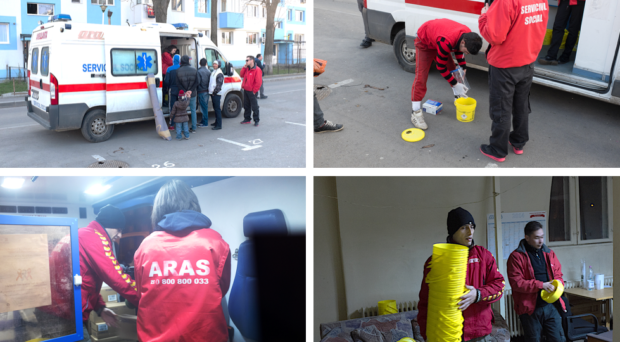
Tell me a bit about ARAS and its involvement in harm reduction in Romania.
ARAS was founded in Bucharest in 1992, and now we have 12 regional offices around the country. Our main missions: preventing HIV, viral hepatitis and STIs; supporting people living with HIV or hepatitis, and their families; and advocating for human rights. ARAS is the only Romanian NGO working with all the key populations for HIV and hepatitis, and we provide services tailored to each population’s needs.
We started offering harm reduction more than 12 years ago with a very simple approach – distributing clean syringes from backpacks. Today we provide needle exchanges, alcohol swabs, methadone therapy, social assistance, psychological counseling, rapid testing for HIV and hepatitis, TB screening and linkage to different kinds of care. We use both dedicated drop-in centers and “social ambulances” that go to where people who use drugs are. We also work with commercial sex workers, the Roma, the homeless and others.
Finally, we devote a lot of energy to advocating for access to treatment for hepatitis C and other diseases.
How has funding for harm reduction changed in Romania in the last few years?
A lot changed after Romania joined the EU in 2007. Key foreign funders left the country, and Romania became ineligible for certain funding sources, most notably HIV grants from the Global Fund to Fight AIDS, Tuberculosis and Malaria. We remained eligible for their TB grants – fortunately, as Romania has the highest burden of TB in the EU. Until the Global Fund harm-reduction projects ended in 2010, harm reduction had always been funded from foreign sources, including the United Nations Office on Drugs and Crime (UNODC), the Open Society Institute, and UNAIDS.
That same year, ARAS was extremely fortunate in acquiring EU structural funding for a project targeting drug users, with the overall goal of social and professional reintegration. That allowed us to continue providing harm-reduction services, unlike other NGOs.
We’re at a critical crossroads because the current TB grant runs out in December, and there’s no other funding available for harm reduction
When that project ended, we got the Bucharest city government to fund another project, which ran for three years and just stopped this summer. Otherwise, harm-reduction efforts have been funded from abroad – from Global Fund TB grants, the Norway Grants and Sidaction. But now we’re at a critical crossroads because the current TB grant runs out in December, and there’s no other funding available for harm reduction. The Romanian Anti-Drug Agency has just started funding harm-reduction outreach projects run by NGOs. It’s a first for the agency, part of a larger initiative called Programs of National Interest.
Tell me about your experience in applying for EU structural funds. What strategies have been most effective in obtaining this funding?
Since 2010, the structural funds have financed several ARAS projects that target drug users, either solely or in part. The line we have been eligible for is “development of human resources,” which in this case means social and professional reintegration. These projects can include social and medical services, but the emphasis is on vocational and professional training.
The authorities who manage the structural funds in Romania did not explicitly request funding for harm reduction, and drug users are not eligible for other funding lines. We keep lobbying them to include users as a target group in the funded projects, and to adapt their guidelines to conditions in the field. The biggest difficulty has been the mandatory collection of personal information for every beneficiary, including a copy of his or her identity card – a challenge with many active drug users. Despite our efforts, we’ve had no success in changing this requirement.
It’s been an ongoing process of adaptation and reinvention
I wouldn’t say we are a best-practice model in obtaining grants. The fact is, that with the structural funds, we had to adapt in order to design and implement fundable projects, projects whose objectives didn’t always align with our original ones. To provide our clients with harm-reduction and health services, we began organizing training in various professions. And so we could keep working with our primary beneficiaries, we started projects that also targeted other vulnerable groups. It’s been an ongoing process of adaptation and reinvention. Unfortunately, the current round of structural funds (2014-2020) has been moving very slowly, and we’ve had great difficulty accessing them.
Hepatology, Medicine and Policy is now accepting submissions on this and related issues. For more information, visit: www.hmap.biomedcentral.com.
Comments